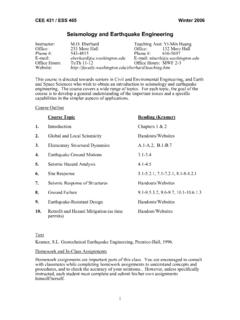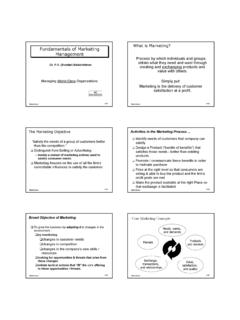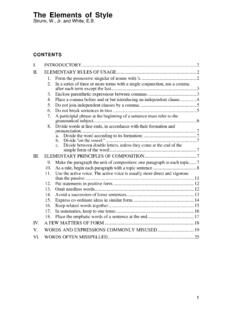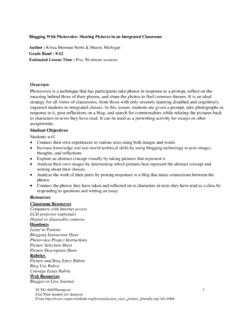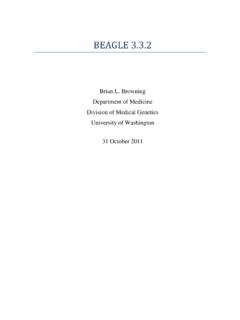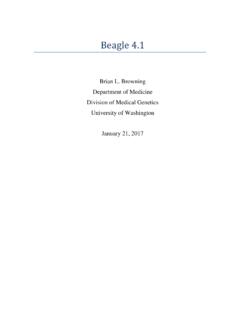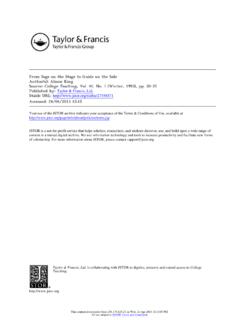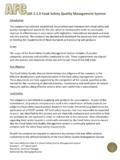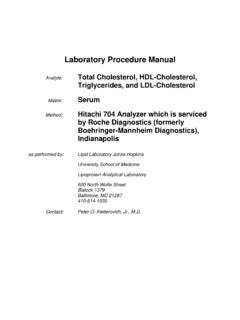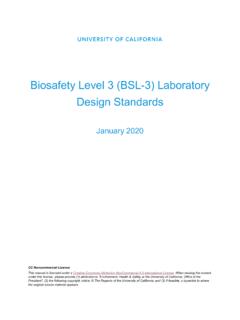Transcription of Laboratory Safety - University of Washington
1 Safety 1 AEESP Environmental Engineering Processes Laboratory manual ( ) Laboratory Safety Deanna Hurum Civil Engineering Northwestern University Laboratory Safety Information for Students Working in the lab can be enjoyable, but there are also risks to be aware of. The goal of this chapter is to familiarize you with the hazards of the lab so that you can get your work done in a timely manner, avoid damaging expensive equipment, and most importantly avoid injuring yourself. These labs are a chance to gain practical experience to complement the knowledge you are gaining in your coursework. Part of that practical experience is learning how to safely work in a Laboratory setting. Safety is important whether you are new to the lab, or an experienced scientist. The primary goal is to teach you how to avoid accidents, as well as what to do when they happen.
2 Learning good habits now is much easier than having to correct bad habits later. There are many different general types of hazards in the lab. Some rules apply to general lab work while others are more specific. The first rule is to ask questions. It is better to avoid injury by asking for help before you get into trouble. If you are unsure of a procedure and what its hazards are, ask your instructor for help. Your instructor is there to guide you in both the experiments in the lab and in the Safety protocols. For every lab, make sure you understand or ask about the following issues: 1. Are the chemicals used hazardous? If yes, in what manner (toxic, carcinogenic, ignitable, reactive, corrosive)? 2. What personal protective equipment should I use? (Remember, Safety glasses should always be worn!) 3. What is the safest way to handle the materials used in this Laboratory ? 4. What should I do if something is spilled? 5. What do I do if I spill a chemical solution on myself?
3 Where are the Safety shower and eye wash? 6. Are there any specific instructions I need to know before using the equipment required in this lab? 7. What do I do with any waste materials generated in this lab? General lab protocols Many things can be done to make the most of your time in lab. The first is to prepare for the lab ahead of time. Read the material and think about the lab before you begin to work. Making a mental plan of what you will be doing in the Laboratory that day can save time and injury in the long run. While you are in the lab, be sure to keep in mind general hazards. Glassware is delicate and easily broken. Wet floors will be slippery. Anything in a flame of a burner will stay hot long after it is removed from the flame. By staying aware of your surroundings you will avoid many common accidents. The Laboratory is inherently dangerous. Eating, drinking, mouth pipetting, and horseplay are not allowed. While you may get away with these habits for a time, they are not safe.
4 Many chemicals are not acutely toxic, but extended low-level exposures have health effects. Eating and drinking in the lab can lead to unintentional poisoning. For the same reasons, food should not be stored, cosmetics should not be applied, and contact lenses should not be handled in the lab. Horseplay in a lab situation is incredibly dangerous. You may feel you are in control of the situation, but you do not know what the person next to Safety 2 AEESP Environmental Engineering Processes Laboratory manual ( ) you is doing. This situation can inadvertently cause injury. The lab is an informal chance for hands-on learning, but it is not a playground. There will be Safety equipment available in the lab. Take full advantage of this equipment. Safety glasses, lab coats, and gloves are for your protection. Your vision is far to valuable to risk not using Safety glasses.
5 Prescription eyeglasses are not a suitable substitute for Safety glasses, and there are many options that fit over prescription glasses. Whenever you are in the lab you should be prepared with either Safety glasses or goggles. The lab coat should be worn only in the lab to protect your clothing. When you are finished with the lab, remove the coat before leaving the room to prevent spreading contamination outside the Laboratory . Gloves will be provided to prevent contact of chemical or biological agents with your hands. There are a wide variety of gloves for different purposes, but the most commonly used are disposable latex gloves. These are good general-purpose gloves that should protect your hands from the majority of agents used in the labs. However, latex allergies are quite common and if you know you have one, please alert your instructor. There are many suitable replacements that do not contain the allergens present in latex. Additionally, there are many situations in the lab for which latex is not the best option.
6 For example, phenol is commonly used in microbiology, but it also permeates latex quickly, making the glove useless as protection from phenol exposure. If you have questions, there are resources to check regarding the best glove for a given use (1). Please remember that gloves only slow the rate of exposure to chemicals, they do not always prevent exposure. Avoid contact with chemical solutions, even with gloves on. If the outside of the gloves get splashed, you should remove those gloves and don clean ones as soon as possible. In addition to the protective clothing available in the lab, please come to lab in appropriate dress. Shorts and sandals are not appropriate at any time. Wear substantial shoes that cover your foot. This way if anything spills to the floor your feet are protected. In general, you want the least amount of exposed skin possible. Clothing acts as an absorbent protector for your skin. When you are finished with the experiment, clean your glassware immediately.
7 Soap and water followed by distilled water is good for general cleaning. Please use caution when handling the wet glass. If you do break glass in the sink, use care in cleaning the sharp broken shards. Broken glass should be disposed of in a separate container from normal trash. If acid washing is required, please follow directions given to you by your instructor. The acid used in an acid bath is very concentrated and dangerous. It is critically important that you wear your lab coat, heavy-duty gloves, and Safety goggles for this cleaning step Before you leave the lab, be sure to thoroughly wash your hands. Hand washing prevents the spread of biological and chemical contaminates and protects you from accidental exposure. There are many good commercial anti-bacterial soaps that both clean and disinfect your hands. Even if you wear gloves, this simple step should not be skipped. Chemical Safety Acids and Bases: There are risks involved in working with any chemical, even water.
8 You should take some time to familiarize yourself with these risks before performing your lab experiment. Some of the most common reagents you will use are acids and bases. Do not mix acids and bases unless you are instructed to do so. The reaction of the two together can release a lot of heat and cause damage. Always dilute acids or bases by adding them to water. If you add water to a concentrated acid the heat released can cause an explosion, spreading acid throughout a room. A simple, albeit silly, way to remember this is that you should add acid to water as you ought-er. Adding the acid or base to the larger volume of water allows the heat to dissipate safely. Safety 3 AEESP Environmental Engineering Processes Laboratory manual ( ) In case of spills: Acid spills should be neutralized with sodium bicarbonate and then cleaned up with a paper towel or sponge.
9 Do not use a strong base, such as sodium hydroxide, to neutralize a strong acid like hydrochloric acid. The sodium bicarbonate will do the job with much less chance of injury. Base spills should be neutralized with boric acid and then cleaned with a paper towel or sponge. Do not use acetic acid or sodium bicarbonate to clean a base spill. The sodium bicarbonate will not neutralize the spill, and acetic acid could react strongly with the base. If you spill an acid or base on your skin, immediately wash well with water. Strong bases react with the oils in your skin to produce a soapy feeling layer. Rinse until well after that feeling is gone. Do not attempt to neutralize a spill on your skin. It can potentially make the injury worse. It is possible that you will be using mercury during these labs. Mercury is commonly found in thermometers and various instruments. If you do have a mercury spill, clean it up immediately with either a commercial product such as Resisorb , Hg Aborb or elemental sulfur.
10 Mercury sponges may also be purchased which form an amalgam with the liquid mercury, trapping it on the surface of the sponge. Mercury is quite volatile even small droplets can cause significant exposure. Be sure to thoroughly clean after a spill. The health affects of mercury are well established and contact with the metal should be minimized. Reagents and Hazardous Waste: When you are getting reagents, never put anything directly into the stock bottle. This could contaminate your stock supply. Instead, pour a small amount into a beaker or clean weigh dish. Once you have added a chemical to a container, label it promptly. When you are finished with the experiment, dispose of the excess chemical as chemical waste. Do not simply pour the excess chemical down the sink. This is a bad habit that is potentially dangerous. The drains of the sinks should not become extra-curricular chemical experiments! Your instructor can help you safely dispose of the chemicals. Biological Safety If you are working with water that may be contaminated with bacteria, or with specific bacterial cultures you should follow some additional Laboratory practices.
